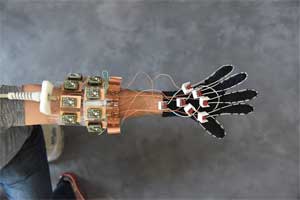- Home
- Editorial
- News
- Practice Guidelines
- Anesthesiology Guidelines
- Cancer Guidelines
- Cardiac Sciences Guidelines
- Critical Care Guidelines
- Dentistry Guidelines
- Dermatology Guidelines
- Diabetes and Endo Guidelines
- Diagnostics Guidelines
- ENT Guidelines
- Featured Practice Guidelines
- Gastroenterology Guidelines
- Geriatrics Guidelines
- Medicine Guidelines
- Nephrology Guidelines
- Neurosciences Guidelines
- Obs and Gynae Guidelines
- Ophthalmology Guidelines
- Orthopaedics Guidelines
- Paediatrics Guidelines
- Psychiatry Guidelines
- Pulmonology Guidelines
- Radiology Guidelines
- Surgery Guidelines
- Urology Guidelines
First of its kind , MRI 'glove' for imaging hand anatomy

In a first of its kind, the researchers from NYU School of Medicine have developed a magnetic resonance imaging (MRI) detector, shaped like a glove, that is capable of capturing clear images of bones, tendons, and ligaments moving together. The study has been published in the journal Nature Biomedical Engineering.
The study was conducted by the research scientist Bei Zhang and colleagues, with an objective to widen the scope of MRI experiments to motionless subjects which have certain limitations in the form of resonant inductive coupling that restricts the coil design to fixed geometries (such as in nuclear magnetic resonance phased array detector).
Since its emergence in the 1970s, MRI has given physicians a better look inside tissues, helping in the diagnosis of millions of maladies ranging from brain tumors to internal bleeding to torn ligaments. Despite this impact, the technology has long struggled with a basic limitation.
MRI works by immersing tissues in a magnetic field such that any hydrogen atoms present align to create an average magnetic force in one direction in each tissue slice. These "little magnets" can then be tipped out of equilibrium by waves of electromagnetic force (radio waves). Once tipped, they spin like tops and also emit radio signals, which reveal their positions and can be rebuilt into images.
MRI has the ability of radiofrequency coils to convert radio waves into a detectable electric current. Unfortunately, this means that the captured ("spinning top") radio waves produce little currents inside receiver coils, which in turn create their own magnetic fields and prevent nearby coils from capturing clean signals.
Advantages of the high-impedance detectors:
- The detectors do not suffer from signal-to-noise degradation mechanisms typically observed with the use of traditional low-impedance elements
- The detectors are adaptive and can accommodate movement, providing access to the imaging of soft-tissue biomechanics with unprecedented flexibility
- They have a high potential in enabling a wide range of applications that are not well suited to traditional coil designs
Uses:
- They can be helpful in the future diagnosis of repetitive strain injuries like carpal tunnel syndrome in office workers, athletes, and musicians
- Enable the construction of a more versatile atlas of hand anatomy, guide surgery with hand images in more realistic positions, or aid in the design of better prosthetics.
The MRI signal is produced by hydrogen atoms (protons), and so this technology excels at imaging soft tissue structures rich in water, each molecule of which includes two atoms of hydrogen. For this reason, MRI is great at imaging muscles, nerves, and even cartilage, which are difficult to study using other non-invasive methods. Tendons and ligaments, however, which are made of dense proteins instead of fluid, remain difficult to see independently, because both appear as black bands running alongside bone.
"Our results represent the first demonstration of an MRI technology that is both flexible and sensitive enough to capture the complexity of soft-tissue mechanics in the hand," says lead author Zhang
The new study found that, in visualizing fingers as they flexed, the new coils revealed how the black bands moved in concert with the bones, which could help to catalogue differences that come with injury.
"We wanted to try our new elements in an application that could never be done with traditional coils, and settled on an attempt to capture images with a glove," says senior author Martijn Cloos, assistant professor from the CAI2R institute in the Department of Radiology at NYU Langone Health. "We hope that this result ushers in a new era of MRI design, perhaps including flexible sleeve arrays around injured knees, or comfy beanies to study the developing brains of newborns."
The researchers found that their system, with the new coils stitched into a cotton glove, generated "exquisite" images of freely moving muscles, tendons, and ligaments in a hand as it played piano and grabbed objects.
For more information log on to: 10.1038/s41551-018-0233-y

Disclaimer: This site is primarily intended for healthcare professionals. Any content/information on this website does not replace the advice of medical and/or health professionals and should not be construed as medical/diagnostic advice/endorsement or prescription. Use of this site is subject to our terms of use, privacy policy, advertisement policy. © 2020 Minerva Medical Treatment Pvt Ltd